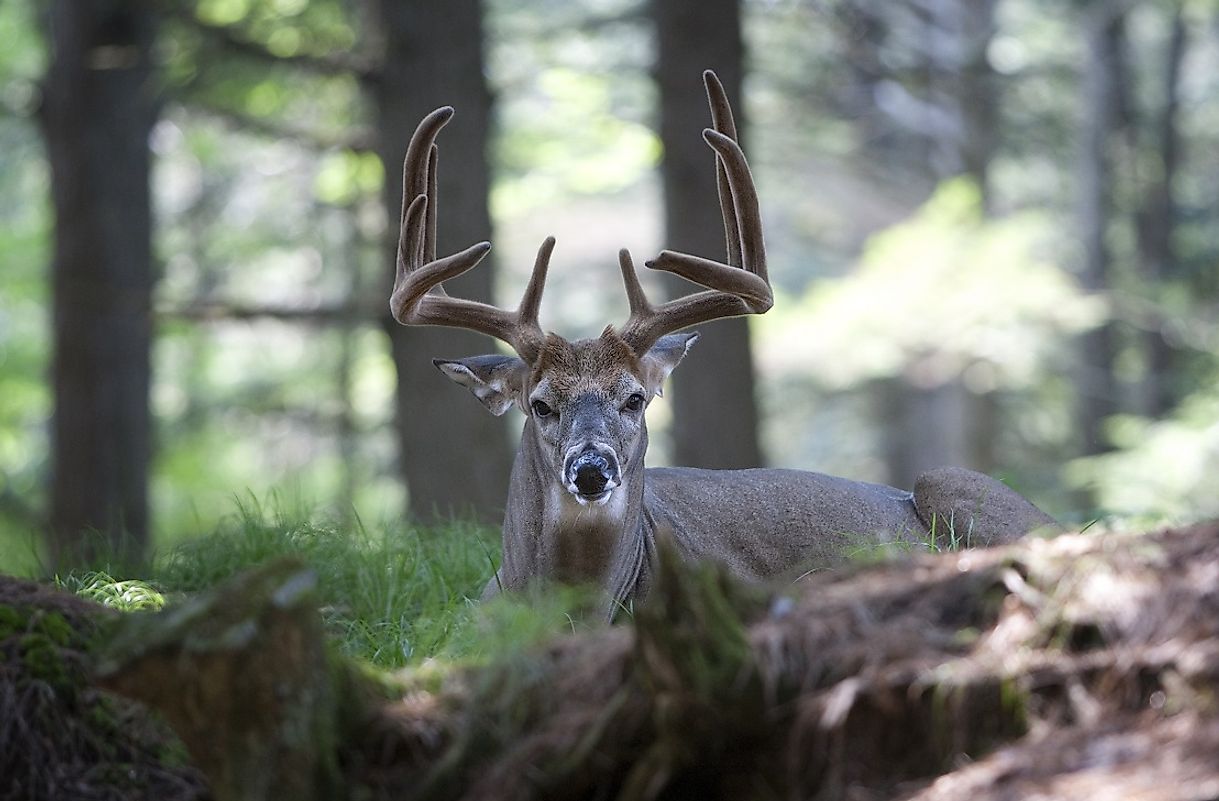White-Tailed Deer Facts: Animals of North America

5. Physical Description
The White-Tailed Deer is one of the smallest members among the deer family in North America, although they vary significantly in terms of size across the regions to which they are native. For instance, North American male White-Tailed Deer, also called "bucks", usually weigh around 100 pounds, but bucks in excess of 400 pounds have also been recorded in the northern regions of Ontario and Minnesota where they are native. The White-Tailed Deer is so named for having a white underside on its tail and white buttocks. The animal is also well known for its habit of arching its tail over its back, revealing its white underside. While in summers the White-Tailed Deer has a reddish coat on its sides and back, and is whitish underneath, while in winters the upper parts turn greyish.
4. Diet
The White-Tailed Deer's diet is dependent upon its location and the time of the year. During spring and summer seasons, the animal’s diet is comprised mostly by leafy components from a number of trees, shrubs, grasses and herbs. During this time, the animal is known to consume mushrooms, fiddleheads and blueberries as well, among other vegetation. When the vegetation fades at the end of spring and summer, the animal depends largely on the twigs and buds during the autumn season. In this season, White-Tailed deer living in the eastern side of Canada are known to gorge on the acorns, while those on the western side consume piles of grain left in farmers' open fields throughout autumn and winter seasons. Like that of grazing livestock, the White-Tailed deer's diet in the winter is dependent on cold-hardy forage, such as evergreen forbs and certain grasses.
3. Habitat and Range
The White-tailed deer is among the most widely distributed, and most numerous, large animals within North America. Its range mainly extends from the southernmost tip of the continent, right up into the coniferous forests on the north of the mainland, where the animal can be found scattered near the Great Slave Lake area in the Northwest Territories of Canada. However, this species is also to be found in Latin American countries, as far south as Peru and Bolivia. There are 16 recognized subspecies of White-Tailed deer, of which only three are found in Canada. Restrictions on the hunting of these animals has led to a flourish in the species’ population and range, especially westwards and northwards within the North American continent. Generally lower severity in recent winters has also been attributed to White-tails' range extensions. Whitetails have also been introduced in the Caribbean region, in such countries as Cuba, Jamaica, the Bahamas, and Puerto Rico, as well as in European countries, such as Finland, the Czech Republic, and Serbia, and also in the country of New Zealand in Oceania.
2. Behavior
Whitetails utilize many forms of communication, including sound, body language, odor, and marking through scratching. When alarmed, the White-Tailed deer raises its tail (and reveals the tail’s white underside) to alert other deer. To mark its territory, the whitetail rubs the scent of its forehead on the areas it has scraped with its hooves, followed by rub-urinating the area. Bucks of the adult whitetails rub-urinate more commonly during the breeding season. White-tailed deer are capable of generating audible noises, and these are unique to each animal. Fawns generate a high-pitched bleating sound to call their mothers. The maternal grunt of a doe, meanwhile, is distinguishable from sounds produced by a buck, with the latter's pitch being lower.
1. Reproduction
In the Northern Hemisphere, the White-Tailed deer's mating season lasts between 1 and 3 months, whereas in tropical zones mating can occur at most times of the year. The mating season, known as “rut”, is the time when the bucks are more active and less cautious than usual. Due to their exercise of less caution, the bucks become easy prey for hunting during the rutting season. The White-Tailed deer is known to reproduce at quick intervals of time, and thusly a healthy herd is well capable to almost double its number within a single year. If conditions are favorable, the female fawn will tend to be mature enough to breed at six to seven months of age, and at one year of age produce one baby, or a "singleton". Young male fawns, meanwhile, are seldom given a chance to breed. Although birth may take place from late March through early August, most fawns in the Northern and Temperate climes are born during the last week of May and the first week of June. A newborn fawn weighs between 2 and 4 kilograms. While twin fawns are possible, especially among healthy females in high-quality feeding ranges, single births are much more common among younger females, especially those giving birth for the first time. Triplets and quadruplets are far less common occurrences still. Single births outnumber double births in poorer ranges, and in places experiencing extremely cold winter conditions.











